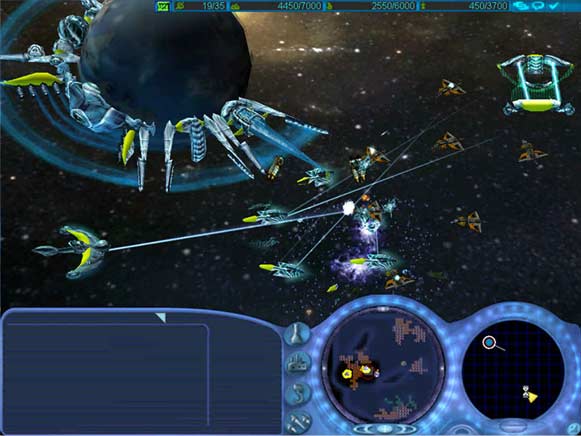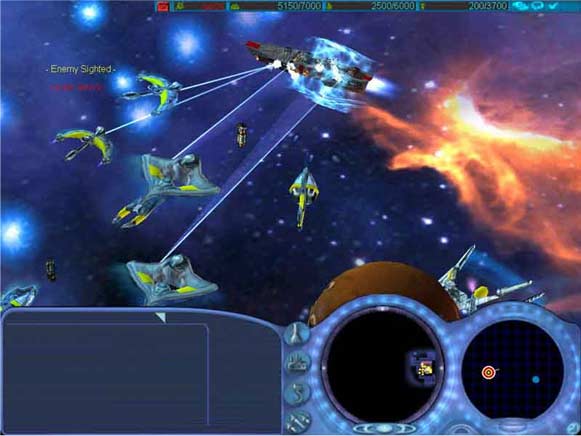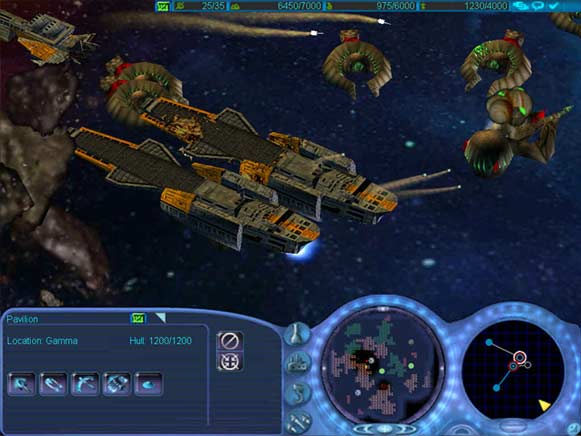Conquest : Frontier Wars
Preview - a hands-on look at the space-bound real-time strategy game that escaped from Digital Anvil's meltdown
Space-based strategy game Conquest has had a troubled history, starting off as one of four games under development at the over-ambitious Texan start-up Digital Anvil before being unceremoniously ditched by its publisher Microsoft at the end of last year. Several months later though the game has finally been completed by producer Eric Peterson's new company, Fever Pitch Studios, and French publisher UbiSoft have picked up the title for an October European release.
We took a look at a beta version of the game to find out if it's all been worth the blood, sweat and tears...

The Final Frontier
Conquest is set some time in the not-so-distant future, with mankind taking its first steps amongst the stars only to discover that we are not alone. A conflict with a bug-like race of aliens known as the Mantis soon ensues in true Starship Troopers fashion, and that's where you come in.
Although it is set in the depths of space, Conquest is a very traditional real-time strategy game in most other ways. Units are modelled in intricate 3D but most of the rest of the game is resolutely two dimensional, and the camera is locked in a fixed isometric perspective which allows you to zoom in and out while keeping the action stuck in a flat plane. This is no Homeworld or FarGate, and the result is a straightforward strategy game which is easy to get to grips with but different enough to stand out from the crowd.
The most notable thing about space though is that it is very big, and very empty. There is no terrain in space, and instead Conquest uses nebulae and asteroid fields to add some strategy to the proceedings. As well as acting as a source of vital ores and gases for your harvesters, they can also speed up or slow down ships passing through them, corrode hulls and disrupt shields and weapon systems. Meanwhile vast anti-matter ribbons act as impenetrable barriers, forcing you to take the long way round or find a back door into the enemy's base.

Fixing A Hole
Battles often take place across three or four sizeable solar systems, with the wormholes linking them serving as chokepoints. These can be controlled by building a jump gate around them which will only allow your own ships to pass through, or simply by positioning a fleet of warships next to the entrance to keep out any unwanted visitors.
Unfortunately this does tend to turn most games into a battle for control of the handful of wormholes in each sector, because once an enemy gets into your solar system the open nature of the maps means that it's hard to stop them from running riot. The nebulae and asteroid fields just don't have enough effect to discourage players from travelling through them, and anti-matter ribbons seem to be few and far between.
The other main focus for battles are the planets in each solar system, which are the only places where you can build vital base facilities such as supply depots, refineries, shipyards and research centers. With limited room around each planet you will need to decide where you want to place your facilities, and later in the game you will have to capture new planets to get more real estate, as well as for the resources that can be mined from them.

Ammunition Low
Planets are particularly important because Conquest's supply system means that combat ships slowly use up ammunition as they fight. If they run out of energy or missiles a fleet can suddenly find itself deep in enemy territory with most of its weapons offline. Not a healthy prospect.
Ships will resupply themselves automatically if they are moved within range of a supply base orbiting a friendly planet, but don't show any initiative in the matter. Defenceless supply ships can also be built to tag along with your fleet and give you a mobile source of fresh ammunition, but they have limited stocks and will eventually have to return to base to resupply themselves, at which point they become sitting ducks for enemy fighters unless you can spare enough ships to protect them. Knocking out the enemy's supply lines is often a good way to grind down an attacking fleet, as eventually they will run out of ammunition and you can pick them off as they flee.
Another innovation included in the game is the addition of "hero" characters, in the form of Admirals who can be assigned to a hot-key selectable fleet. These officers provide a range of bonuses to the ships under their command, and can also be called on to carry out orders such as search and destroy - exploring a map and killing anything they meet which has more than two legs. This takes some of the load off the player, and their habit of whining when they come under attack or start to run low on supplies means that you can leave them to their own devices and focus on another solar system without completely losing track of them.

Skirmish
While the single player campaign will introduce you to the game gently, with each new mission opening up new ship types and facilities to build, as with most real-time strategy games the real juice is to be found in the skirmish and multiplayer modes.
Here up to four players or eight AI characters can battle it out in random or pre-designed maps, with anything up to sixteen solar systems to fight your way across. With the entire tech tree available to research during the course of a single game, battles can be brutal, especially once the all-conquering dreadnoughts and ion cannons and their alien equivalents come into play.
Unfortunately the number of units which you can command simultaneously is so limited that you will find your forces stretched very thin in a large game, unless you plump for a teamplay match. With a maximum of 200 command points available to you and even the most basic fighter requiring two of them, it's rare for each side to have more than a few dozen ships at any one time, and when you scatter those across sixteen sizeable solar systems it makes for slim pickings.
Which is a shame, because it limits the scope of what could have been a truly epic real-time strategy game. In Conquest space is big, but the battles you fight over it are usually little more than minor skirmishes. It's enjoyable enough, but lacks the grandeur that the subject matter really deserves.
-
The Death Of The Celebrity Studio

